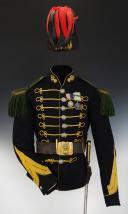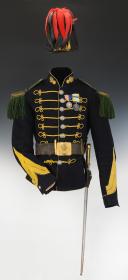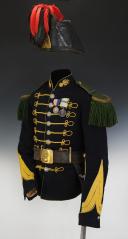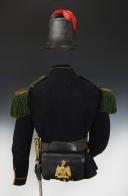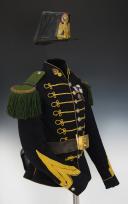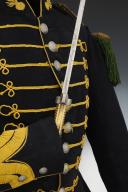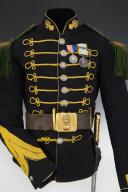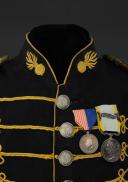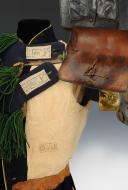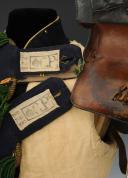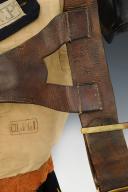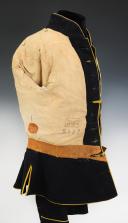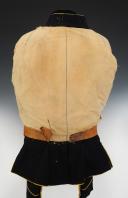
UNIFORM OF CORPORAL FRÉDériC THÉBAULT, OF THE FOOT HUNTER BATTALION OF THE IMPERIAL GUARD, Second Empire. 26846
Sold out
UNIFORM OF CORPORAL FRÉDériC THÉBAULT, OF THE FOOT HUNTER BATTALION OF THE IMPERIAL GUARD, Second Empire. 26846
SHAKO, model 1860.
Shako Taconet entirely in black patent leather, H at the front 13 cm, H at the back 19 cm. Cap, diameter 13 cm, in black waxed leather. Upper patent leather braid, H 1.5 cm. Bourdalou in patent leather, H 2 cm. On each side, two patent leather strips form a V (width of each strip 1.5 cm). On the barrel, in the upper part in the center of the V, a black lacquered metal aerator (diameter 1.8 cm) is fixed. Square visor in black patent leather with green waxed interior, width at the center 3.7 cm. Tricolor lacquered metal cockade embossed with a radiant sun, diameter 5 cm. Gilded brass shako plate stamped and cut in the shape of a crowned imperial eagle placed on a globe struck with a hunting horn with sparkling Jupiter spindle, H of the plate 11.5 cm, width 10 cm; at the base of the crown. Black waxed leather interior sweatband. Black patent leather chin strap attached to the inside of the frame. Plume in hanging rooster feathers mixed green and scarlet, H 20 cm.
Very well preserved.
NOTE :
This 1860 model shako has an unknown exact date of adoption, probably around February 1860.
CAPORAL'S HABIT, model 1860.
In dark blue cloth, closing straight at the front with nine buttonholes garnished on both sides with 14 cm of daffodil cord frog ending with a clover. Half-curved pewter uniform buttons decorated with the imperial eagle and the inscription “GARDE IMPERIALE”. Collar in dark blue cloth piped daffodil trimmed at the front on each side with a badge in dark blue cloth embroidered in daffodil wool with a flaming bomb, H of the bomb 5.5 cm, width 21.5 cm. Facings in dark blue piped daffodil cloth forming a point at the front, topped with two daffodil-colored “cul de dé” woven braids. These facings are garnished with two small module uniform buttons. Two false rear pockets in blue piped daffodil cloth forming two points, each garnished with two large-module uniform buttons. Rolled back each garnished with a dark blue badge embroidered with a flaming daffodil-colored bomb, H of the bomb 4.7 cm, width 2.5 cm. Belt tab in dark blue daffodil piped cloth with one small module uniform button. Shoulder pad loops in dark blue cloth covered with a 1 cm wide dark green thimble fabric braid. At the base of the collar at the level of the epaulettes, a small module uniform button is sewn on each side. Interior lining in blue cloth and beige canvas with ocher leather waist belt, marked with black ink stamps of the Guards Foot Hunters Regiment “CH. to P. GI”, dated 3rd quarter 1863 “3e.63”, registered “2597”.
Very good condition, some wear on the soutaches at the buttons, the soutache in the upper part of the left side is missing.
NOTE: This outfit is reproduced in the work of Louis Delpérier THE IMPERIAL GUARD OF NAPOLÉON III, Éditions du Canonnier 2000, illustrations 141 to 148.
SHOULDER PAULETTES.
Green wool body, gold turnings, soft green wool fringes, lined with dark blue cloth with beige canvas label, with regimental stamp in black ink: imperial crown followed by the initials “C.P.”. They bear the number “228”.
Good condition, slightly sunburned.
BELT.
In blackened, waxed cow, half-fed, flower outside. Consists of a band to which is permanently adapted a two-branched pendant cut from a single piece, registered “1312” (?). At the bottom of this pendant, a gusset of the same leather is superimposed and assembled on each side with double seams flanged at the top and bottom. This gusset is pierced with a notch to receive the trigger guard of the saber bayonet scabbard, and below is a small loop to stop the counter-strap of this scabbard. At the front end of the strip (side of the pendant) is a copper yoke in which the strip is passed double and where its fold is stopped by a quadrangular bar called a lock, movable on the yoke and which allows it to be lengthened and to shorten the belt strip as desired without any barb and by simply pressing the lock. At the other end is a copper plate stamped with a grenade in relief, internally furnished with a trigger guard, a bolt and a clip which engages in the yoke at the other end of the band.
Two copper slides (height 78 mm, width 9 mm, thickness 11 mm) are movable along the belt strip, one at each end, and are used to receive the support hooks adapted to the bag straps.
Rectangular belt plate with cut corners, in brass, H 6.5 cm, width 7.8 cm. Complete with its hook and its trigger guard, stamped on the trigger guard “COTTIAU”.
Very good state.
CARTRIDGE.
A box or casket in blackened and waxed cowhide, flowers on the outside, presenting two sides, a front, a back and a bottom with two interior partitions, assembled by stitched seams without borders. Inside, two large compartments to each hold a packet of cartridges, and between the two large ones a small one for essentials and the bullet puller. H 11 cm, L18.5 cm, thickness 5.5 cm.
A half-fed cow flap, blackened, waxed, flower outside, bent squarely at its assembly with the box and furnished with two corners or side edges, in its curved upper part. A cow girth sewn towards the bottom attaches to a copper button, in a drop of tallow and with a groove, riveted to the bottom of the box, H 13 cm, L 20.7 cm. The tab is decorated with a crowned eagle in cut-out copper, total height 9.5 cm, maximum width 8 cm. The back of the pallet is hot stamped with the regiment “G.I.Cha.P.”, registered “707”, dated “1854” and the manufacturer “C. DELACHAUSSÉE”.
Loop in strong cowhide, half-fed, blackened and waxed, sewn to the back of the box, and presenting, when developed, the shape of a trapezoid 10.5 cm high; 15 cm wide base, and 10.5 cm at the top. The large base is sewn with double stitching at the same time as the tab is assembled with the back of the box. The loop is then reused on the outside, and its smallest base is assembled against the back of the box by two parallel seams.
Capsule bag in blackened calfskin, garnished inside with a collar in curly lamb. It is sewn on the front of the box, and carries a small skate, a counter-girth and a small bone button.
In a perfect state.
YATAGAN BAYONET, Chassepot model.
Fluted brass handle with 15 cords. Brass cruiser with downward curved quillon. Double-curved blade called Yatagan, signed “Mer Imple de Chat 9bre 1856 = S.B Ml 1842”, length 57.4 cm. Steel scabbard.
Good condition, some oxidation.
COMMEMORATIVE MEDAL OF THE ITALIAN CAMPAIGN, created in 1859.
Round in silver, representing on the obverse the effigy of the Emperor crowned with laurel, framed by the legend “NAPOLEON III EMPEREUR”. On the reverse, inscription “ITALY CAMPAIGN - 1859” framing the name of the battles of “MONTEBELLO, PALESTRO, TURBIGO, MAGENTA, MARIGNAN, SOLFERINO”.
Ribbon buckle for the Italian campaign (in silk alternating 6 red vertical stripes and 5 white vertical stripes), and the ribbon of the Sardinian military valor medal.
Good condition
BRITISH MEDAL OF THE CRIMEAN CAMPAIGN, created in 1854.
Round in shape, in silver engraving by Wyon, representing on the obverse side the portrait of Queen Victoria head turned to the dexter, bordered with the legend "VICTORIA REGINA", on the reverse side Roman soldier crowned by the allegory of Victory bearing the legend on the “CRIMEA” side. Moiré sky blue silk ribbon bordered with a yellow vertical stripe, silver bail. “SEBASTOPOL” silver clasp.
Good condition.
France.
Second Empire.
Good condition.
BIOGRAPHY :
The markings of the coat: letters CH. to P. GI., receipt in the 3rd quarter of 1863 with registration number 2597 allows its owner to be identified: Frédéric Thébault, carpenter born August 24, 1835 in Sonzay (Indre-et-Loire), he measured 1.65 m, red eyes, brown hair and eyebrows, with scar on the chin and colored complexion... Incorporated into the Guard on August 18, 1859 from the 8th battalion of hunters. He served in the sixth then the second company.
Holder of the Italian Medal, he enlisted on April 4, 1856. He re-enlisted for 7 years in May 1862 before being released on December 31, 1869. The service register remains silent on the date of his promotion to the rank of corporal.
338 / 5 000
Résultats de traduction
Résultat de traduction
HISTORY:
This set recalls the exploit of the hunter MONTELLIER, corporal in the battalion of foot hunters of the Guard, around 1865, and who conquered in Solferino on June 24, 1869, an Austrian flag at the point of his saber bayonet. This action was to earn the cross of the Legion of Honor to its author as well as to the battalion.
SHAKO, model 1860.
Shako Taconet entirely in black patent leather, H at the front 13 cm, H at the back 19 cm. Cap, diameter 13 cm, in black waxed leather. Upper patent leather braid, H 1.5 cm. Bourdalou in patent leather, H 2 cm. On each side, two patent leather strips form a V (width of each strip 1.5 cm). On the barrel, in the upper part in the center of the V, a black lacquered metal aerator (diameter 1.8 cm) is fixed. Square visor in black patent leather with green waxed interior, width at the center 3.7 cm. Tricolor lacquered metal cockade embossed with a radiant sun, diameter 5 cm. Gilded brass shako plate stamped and cut in the shape of a crowned imperial eagle placed on a globe struck with a hunting horn with sparkling Jupiter spindle, H of the plate 11.5 cm, width 10 cm; at the base of the crown. Black waxed leather interior sweatband. Black patent leather chin strap attached to the inside of the frame. Plume in hanging rooster feathers mixed green and scarlet, H 20 cm.
Very well preserved.
NOTE :
This 1860 model shako has an unknown exact date of adoption, probably around February 1860.
CAPORAL'S HABIT, model 1860.
In dark blue cloth, closing straight at the front with nine buttonholes garnished on both sides with 14 cm of daffodil cord frog ending with a clover. Half-curved pewter uniform buttons decorated with the imperial eagle and the inscription “GARDE IMPERIALE”. Collar in dark blue cloth piped daffodil trimmed at the front on each side with a badge in dark blue cloth embroidered in daffodil wool with a flaming bomb, H of the bomb 5.5 cm, width 21.5 cm. Facings in dark blue piped daffodil cloth forming a point at the front, topped with two daffodil-colored “cul de dé” woven braids. These facings are garnished with two small module uniform buttons. Two false rear pockets in blue piped daffodil cloth forming two points, each garnished with two large-module uniform buttons. Rolled back each garnished with a dark blue badge embroidered with a flaming daffodil-colored bomb, H of the bomb 4.7 cm, width 2.5 cm. Belt tab in dark blue daffodil piped cloth with one small module uniform button. Shoulder pad loops in dark blue cloth covered with a 1 cm wide dark green thimble fabric braid. At the base of the collar at the level of the epaulettes, a small module uniform button is sewn on each side. Interior lining in blue cloth and beige canvas with ocher leather waist belt, marked with black ink stamps of the Guards Foot Hunters Regiment “CH. to P. GI”, dated 3rd quarter 1863 “3e.63”, registered “2597”.
Very good condition, some wear on the soutaches at the buttons, the soutache in the upper part of the left side is missing.
NOTE: This outfit is reproduced in the work of Louis Delpérier THE IMPERIAL GUARD OF NAPOLÉON III, Éditions du Canonnier 2000, illustrations 141 to 148.
SHOULDER PAULETTES.
Green wool body, gold turnings, soft green wool fringes, lined with dark blue cloth with beige canvas label, with regimental stamp in black ink: imperial crown followed by the initials “C.P.”. They bear the number “228”.
Good condition, slightly sunburned.
BELT.
In blackened, waxed cow, half-fed, flower outside. Consists of a band to which is permanently adapted a two-branched pendant cut from a single piece, registered “1312” (?). At the bottom of this pendant, a gusset of the same leather is superimposed and assembled on each side with double seams flanged at the top and bottom. This gusset is pierced with a notch to receive the trigger guard of the saber bayonet scabbard, and below is a small loop to stop the counter-strap of this scabbard. At the front end of the strip (side of the pendant) is a copper yoke in which the strip is passed double and where its fold is stopped by a quadrangular bar called a lock, movable on the yoke and which allows it to be lengthened and to shorten the belt strip as desired without any barb and by simply pressing the lock. At the other end is a copper plate stamped with a grenade in relief, internally furnished with a trigger guard, a bolt and a clip which engages in the yoke at the other end of the band.
Two copper slides (height 78 mm, width 9 mm, thickness 11 mm) are movable along the belt strip, one at each end, and are used to receive the support hooks adapted to the bag straps.
Rectangular belt plate with cut corners, in brass, H 6.5 cm, width 7.8 cm. Complete with its hook and its trigger guard, stamped on the trigger guard “COTTIAU”.
Very good state.
CARTRIDGE.
A box or casket in blackened and waxed cowhide, flowers on the outside, presenting two sides, a front, a back and a bottom with two interior partitions, assembled by stitched seams without borders. Inside, two large compartments to each hold a packet of cartridges, and between the two large ones a small one for essentials and the bullet puller. H 11 cm, L18.5 cm, thickness 5.5 cm.
A half-fed cow flap, blackened, waxed, flower outside, bent squarely at its assembly with the box and furnished with two corners or side edges, in its curved upper part. A cow girth sewn towards the bottom attaches to a copper button, in a drop of tallow and with a groove, riveted to the bottom of the box, H 13 cm, L 20.7 cm. The tab is decorated with a crowned eagle in cut-out copper, total height 9.5 cm, maximum width 8 cm. The back of the pallet is hot stamped with the regiment “G.I.Cha.P.”, registered “707”, dated “1854” and the manufacturer “C. DELACHAUSSÉE”.
Loop in strong cowhide, half-fed, blackened and waxed, sewn to the back of the box, and presenting, when developed, the shape of a trapezoid 10.5 cm high; 15 cm wide base, and 10.5 cm at the top. The large base is sewn with double stitching at the same time as the tab is assembled with the back of the box. The loop is then reused on the outside, and its smallest base is assembled against the back of the box by two parallel seams.
Capsule bag in blackened calfskin, garnished inside with a collar in curly lamb. It is sewn on the front of the box, and carries a small skate, a counter-girth and a small bone button.
In a perfect state.
YATAGAN BAYONET, Chassepot model.
Fluted brass handle with 15 cords. Brass cruiser with downward curved quillon. Double-curved blade called Yatagan, signed “Mer Imple de Chat 9bre 1856 = S.B Ml 1842”, length 57.4 cm. Steel scabbard.
Good condition, some oxidation.
COMMEMORATIVE MEDAL OF THE ITALIAN CAMPAIGN, created in 1859.
Round in silver, representing on the obverse the effigy of the Emperor crowned with laurel, framed by the legend “NAPOLEON III EMPEREUR”. On the reverse, inscription “ITALY CAMPAIGN - 1859” framing the name of the battles of “MONTEBELLO, PALESTRO, TURBIGO, MAGENTA, MARIGNAN, SOLFERINO”.
Ribbon buckle for the Italian campaign (in silk alternating 6 red vertical stripes and 5 white vertical stripes), and the ribbon of the Sardinian military valor medal.
Good condition
BRITISH MEDAL OF THE CRIMEAN CAMPAIGN, created in 1854.
Round in shape, in silver engraving by Wyon, representing on the obverse side the portrait of Queen Victoria head turned to the dexter, bordered with the legend "VICTORIA REGINA", on the reverse side Roman soldier crowned by the allegory of Victory bearing the legend on the “CRIMEA” side. Moiré sky blue silk ribbon bordered with a yellow vertical stripe, silver bail. “SEBASTOPOL” silver clasp.
Good condition.
France.
Second Empire.
Good condition.
BIOGRAPHY :
The markings of the coat: letters CH. to P. GI., receipt in the 3rd quarter of 1863 with registration number 2597 allows its owner to be identified: Frédéric Thébault, carpenter born August 24, 1835 in Sonzay (Indre-et-Loire), he measured 1.65 m, red eyes, brown hair and eyebrows, with scar on the chin and colored complexion... Incorporated into the Guard on August 18, 1859 from the 8th battalion of hunters. He served in the sixth then the second company.
Holder of the Italian Medal, he enlisted on April 4, 1856. He re-enlisted for 7 years in May 1862 before being released on December 31, 1869. The service register remains silent on the date of his promotion to the rank of corporal.
338 / 5 000
Résultats de traduction
Résultat de traduction
HISTORY:
This set recalls the exploit of the hunter MONTELLIER, corporal in the battalion of foot hunters of the Guard, around 1865, and who conquered in Solferino on June 24, 1869, an Austrian flag at the point of his saber bayonet. This action was to earn the cross of the Legion of Honor to its author as well as to the battalion.
Reference :
26846
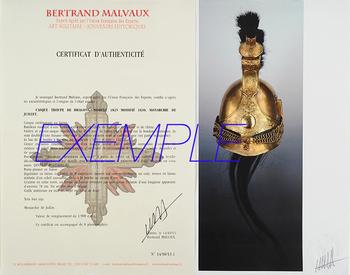
Next update Friday, april 4th at 1:30 PM
FOR ALL PURCHASES, PAYMENT IN MULTIPLE CHECKS POSSIBLE
bertrand.malvaux@wanadoo.fr 06 07 75 74 63
An authenticity certificate of the item including the description published on the site, the period, the sale price, accompanied by one or more color photographs is automatically provided for any item priced over 130 euros. Below this price, each certificate is charged 5 euros.
Only items sold by me are subject to an authenticity certificate, I do not provide any expert reports for items sold by third parties (colleagues or collectors).
